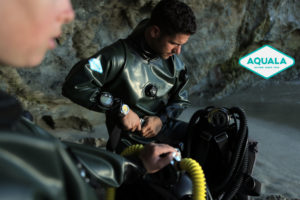Evolving the Modern Drysuit The Cordell from Aquala
When I took over Aquala in 2000, in all honesty, I knew very little about drysuits. The history of Aquala was what captured my attention and having already been in business as well as an experienced diver, everything else I knew I could learn.
Some say a lack of drysuit knowledge would be stacking the deck against myself, but I disagreed. I saw it as coming to the table with a clean slate, absent of bias, and ready to learn it all. Ready to take Aquala suits to the next level, and that’s exactly what I did.
After a week-long crash course in drysuit construction by the prior owner’s head craftsman, we had the foundation for what was needed. There were orders on the books, so production started immediately. The first Louisiana built Aquala suits were well on their way.

With orders fulfilled, I began building a suit for myself. I dove it deep into lakes, made many trials in the Gulf of Mexico, and took it into underwater caves and caverns. I began to understand the Aquala’s strengths and it’s weaknesses. Some, when they focus on their product, might focus on the strengths. Me, I focused on the weaknesses because that’s how one builds a better suit.
Building better meant examining every aspect, so I began with the Aquala-ply itself. Back in the early 2000s, Aquala was over 50 years old, and unintentional changes had been made to the Aquala-ply formula. I found the tear strength insufficient, so I consulted my supplier and we started analyzing the compounds. After minor adjustments to the formula, the result was an Aquala-ply with a puncture and tear resistance that hadn’t been seen in over 20 years.
Next, I began talking to my customers, primarily the ones using the suits for commercial applications. I asked them their thoughts on how to make improvements. They pointed out places such as the four-way intersection seam below the arms, which had a potential to leak. I began looking at the patterns and changed them to make the sleeves a seamless integration of the torso. The result was more material usage, but the suits became leakproof in that area.
Linear seams, like the ones on the inseam and waist, were always durable, but if a suit was going to leak it was going to leak at the seams. How could that be improved? While the process was time-consuming and tedious, I implemented a way to use strips of Aquala-ply by making a tape to reinforce the exterior seam of each suit. Now the exterior seams were double reinforced.
 Then I looked at the interior of the suit. If the outside seam was reinforced, why not the inside as well? Another strip of tape would hinder flexibility and mobility, so there had to be another way. My research let to experimenting with liquid polymers. I found a polymer that worked well with the Aquala-ply, which also had applications in marine use. If it’s good enough to seal the hulls of high speed, offshore fishing boats, then it’s good enough for an Aquala.
Then I looked at the interior of the suit. If the outside seam was reinforced, why not the inside as well? Another strip of tape would hinder flexibility and mobility, so there had to be another way. My research let to experimenting with liquid polymers. I found a polymer that worked well with the Aquala-ply, which also had applications in marine use. If it’s good enough to seal the hulls of high speed, offshore fishing boats, then it’s good enough for an Aquala.
After ten years of diving, listening, experimenting, and revising, I created what we would call today, the Cordell. A suit of true evolution and is the greatest Aquala suit yet.
Classic and authentic yet modern and new, the Cordell is as good as it gets. It’s my go-to suit, and it could also be yours.
So...when are we building one for you?
Ty Alley


